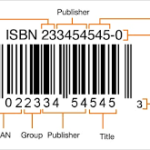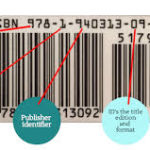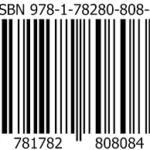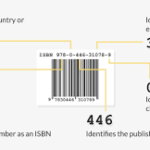ISBN/ISSN/RNI Registration
We can help you obtain the International Standard Book Number for your book.
WHAT IS AN ISBN?
ISBN is an acronym for International Standard Book Number, is a unique 13-digit numeric code used to identify the commercial books. Earlier, ISBN consisted of 10 digits till December 2006. After 1 January 2007, this was increased to 13. The ISBN is allotted after calculation with a secret mathematical formula. Moreover, they consist of a ‘check-digit’ to validate the number.
STRUCTURE OF AN ISBN NUMBER
Every ISBN comprises 5 essential components and each segment is separated with spaces (below barcode) or hyphens (above barcode). The 5 elements of ISBN code have been given below:
- Prefix element – The ISBN number begins with 978 or 979. This is the prefix element.
- Registration group element – This part denotes the particular country, state, or region from the international ISBN system. This may consist of 1 to 5 digits.
- Registrant element – This element is to identify the publisher. This may comprise up to 7 digits in length.
- Publication element – This part signifies the specific edition and format of a particular title. This can be of up to 6 digits.
- Check digit – This is the concluding part, which is the last single digit of the ISBN code. It mathematically validates the rest part of the ISBN number. This is basically calculated with a “Mod 10” system with alternating weights of 1 and 3
DOCUMENTS REQUIRED FOR ISBN Registration
ID Proof of Author
Content of Book
Description of Book Cover Page of the book Title of the book
Publisher & Printer Details
FREQUENTLY ASKED QUESTIONS
Q. Who needs an ISBN number?
An ISBN code is used by the book publishers, book dealers and libraries for the purpose of ordering, listing and stock management. It enables them to distinguish the publishers and enables them to recognise a specific edition of a specific title in a particular format.
Q. Where can we get the ISBN number?
ISBNs are allocated to Publishers in the country where their head office is situated. This is truly irrespective of the language of the publication or the target market for the book.
Q. What all products can’t be alloted an ISBN?
The following products that are not text-based in nature, do not qualify for an ISBN:
- Serials, periodicals, magazines and journals.
- Record books
- Audio/Video VCDs, DVDs and other media
- Computer games
- Computer application
- Items available to a restricted group, e.g. a course book only available to student on the course.
- Websites
- Other Non-text-based publications.
Q. Who is eligible for ISBN Registration?
Following persons are eligible for ISBN Registration-
- Any Publisher who is involved in the publication of valid product for sale and distribution in the market
- Any author whose name is given on the cover page of the book along with the title,
- Institutions holding Seminars and Conferences on a specific topic.
Q. Can we pass on the unused ISBN to other users?
No, unused ISBN Registration can’t be passed on to other users. An ISBN code is broken down into group identifier, publisher identifier and title identifier. This means all ISBN numbers show publisher identifier, and all products identified by ISBN from that batch will be considered as being published by that publisher
Q. What is an ISBN?
ISBN stands for International Standard Book Number. It is a unique 13-digit numeric code used to distinguish the commercial books. The ISBN Registration is allotted by calculation using a secret mathematical formula. Moreover, they consist of a ‘check-digit’ to validate the number.




ISSN – International Standard Serial Number
ISSN is a worldwide identification code used by publishers, suppliers, libraries, information services, bar coding systems, union catalogues, etc. for citation and retrieval of serials such as journals, newspapers, newsletters, directories, yearbooks, annual reports & monograph series, etc.. The benefits include international publicity and recognition of the serial by automatic inclusion in the International Serials Directories.
ISSN International Centre is a network with its Headquarters at Paris and National Institute of Science Communication and Information Resources (NISCAIR) is the national centre of ISSN international centre for assigning ISSN to serials published in India.
Who can obtain ISSN?
a. Any new serial print or e whose first issue is yet to be brought out.
b. An existing serial publication which does not have ISSN.
c. Changed serial title(s) whose old titles had already an ISSN.
Publications eligible for ISSN assignment
1-Please request an ISSN only if your publication, being print or electronic belongs to one of the categories below:
A- Serials, journals, newspapers, magazines, monographic series (ISO standard 3297:2007 that defines the identification of serials and other continuing resources).
B- Please note that books are not eligible for ISSN assignment
REQUIRED DOCUMENT FOR ISSN REGISTRATION
- Additionally, editorial boards with complete addresses of the editorial board members including, designation, department, official/institutional email addresses of the members and full contact address of publisher with publisher name should be displayed on the journal website.
- For International journals, the Editorial Board has to be international in scope with some of the Editorial Board members belonging to reputed institutions from abroad.
- For scholarly journal(s), Editorial Board Members should be senior faculty members. Students, Research Fellows etc. as editorial members of scholarly journals may be avoided.
- The journal should have a valid URL and should cover a precise subject or address a specific target audience.
- Journal(s)/Serial(s) brought out by institutions/organizations should be linked to the institution/organization website.
- Displaying of misleading/false information in the website will result in rejection of the application.
- The name and complete postal address (Specifically India) of the publisher must be displayed on the publication or publication website. Please note that it is particularly important for the name of the publisher and the place of publication to be printed or displayed on the serial.
- ISSN assigned to a specific format should be clearly indicated in the publication.
- Using of ISSN assigned to one format for another format is not allowed.
- Changing of ISSN assigned Title without informing the Centre will result in revoking the ISSN.
- if validation copy of ISSN assigned journal is not submitted after assignment, ISSN assignment to the publisher’s new journals will be denied.
- Any mistake or false information in the application will lead to the rejection of the application.
- Journals changing titles must mention the details of Old title, ISSN and the details of issues published during that period in the new journal or journal website.
RNI REGISTRATION
PROCEDURE/GUIDELINES FOR REGISTRATION
- STEP 1: VERIFICATION OF TITLE
- The publisher should get the required title verified after applying online as per the procedure and guidelines for title verification.
- STEP 2: AUTHENTICATION OF DECLARATION
- After downloading the title verification letter from RNI website, the same should be presented to forwarding authority concerned (DM/DC/SDM/DCP/JCP/CMM etc.) along with properly filled declaration (Form-I) for authentication.
- If publisher and printer are different persons, then separate declarations from both publisher and printer are required.
- If place of publication and printing press are in different districts then separate declarations are required from both the districts
- The publisher should file declaration from the district of place of publication and printer should file declaration from the district of printing press
- STEP 3: PUBLICATION OF VOLUME/YEAR-1 ISSUE-1
- Under section 5 (5) of PRB Act 1867, volume/year-1 issue-1 should be brought within 42 days of authentication of declaration, if periodicity is daily or weekly.
- If periodicity is fortnightly or above, volume/year-1 issue-1 should be brought out within 90 days of authentication of declaration.
- If place of publication and printing press are in different districts, then the date of authentication of place of publication declaration filed by the publisher will be considered for calculating 42/90 days for beginning of volume-1 issue-1.
- In case volume-1 issue- 1 is not brought out within the required time period, a revised declaration should be filed and volume-1 issue-1 should be brought out within the required period from the date of authentication of revised declaration.
- The publication should be printed in the press mentioned in the declaration.
- The publication should primarily contain news/views/articles etc and in case of bilingual/multilingual publications, news/views/articles etc should be brought out in all the languages of the publication.
- GUIDELINES TO PRINT MASTHEAD
- To ensure distinctiveness of the title, it should be displayed in the masthead, as verified and should not resemble/imitate any existing title.
- The title shall be displayed in uniform font/letter size in mast head of the publication. The difference in font/letter size should not be more than 25%.
- The title shall be displayed either horizontally or vertically.
- In case of bilingual/multilingual publications the title in the masthead should be displayed in anyone of the languages of publication.
- Periodicity should not be mentioned along with the title in the masthead if it is not part of the verified title.
- If title displayed in the masthead is in language other than English or Hindi, the same should also be displayed in English/Hindi (It should be as verified and not translation and it can be in smaller font size).
- The masthead space should also carry dateline containing volume and issue number, date/month/year, periodicity, price and publication city, in the language of publication and also in English/Hindi in case of publications in languages other than English and Hindi.
- Each page should display the title, page number, and date/month/year of publication.
- GUIDELINES FOR IMPRINT LINE
- The imprint line should be printed legibly as “Printed by___ Published by___ on behalf of ___ (name of owner) __ and Printed at ___( name and complete address of printing press)___ and published from ___ complete address of place of publication___ Editor ___.
- In case of publications in languages other than English or Hindi, the imprint line should also be displayed in English/Hindi for reference. It can be in smaller font size.
- The name of Editor given in the imprint line should be same as mentioned in the declaration. Editor-in-chief, Sub Editor, Chief Editor, Resident Editor etc should not be mentioned as a part of the imprint line.
- As per section 3 of PRB Act 1867 the imprint line should be legible. Hence, the font size and placement of imprint line should be such that it is legible and clearly visible. There is no specific place recommended for imprint line however, bottom of page 3 or last page of the publication should be preferred so that it can be easily located.
